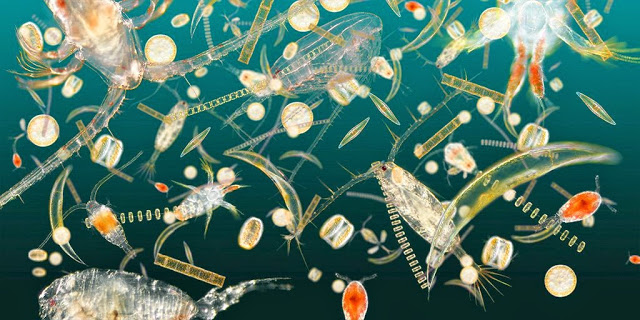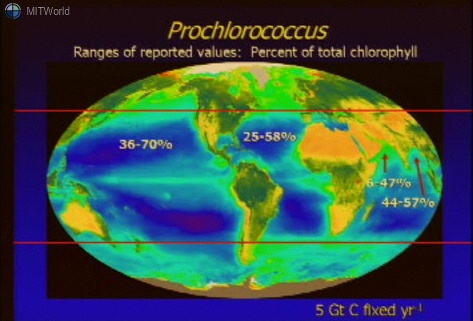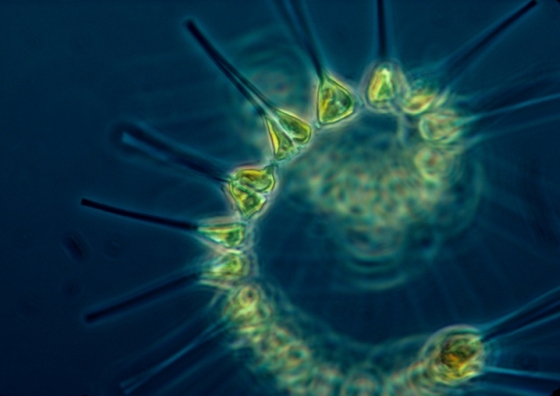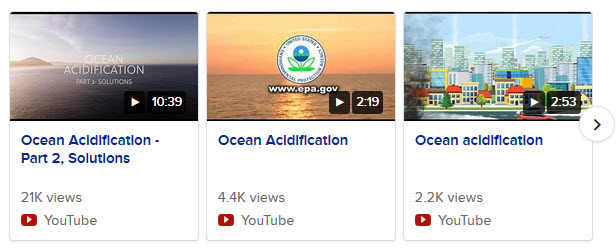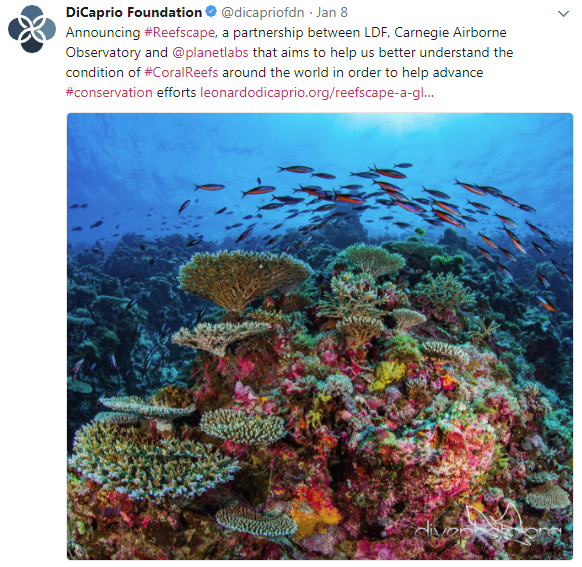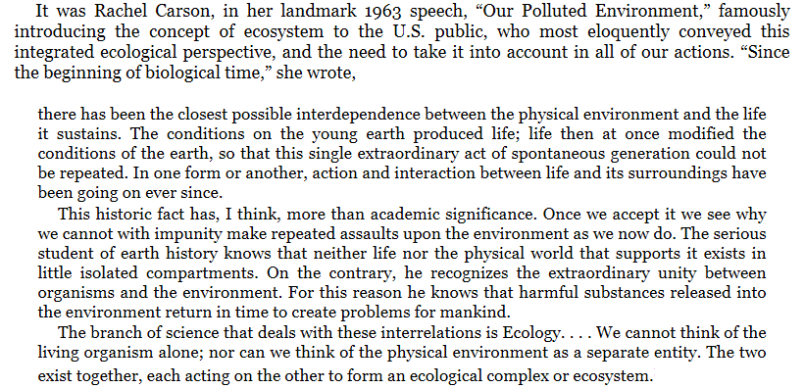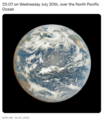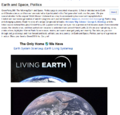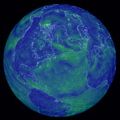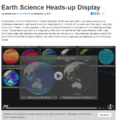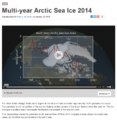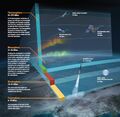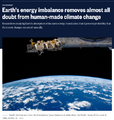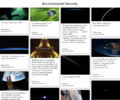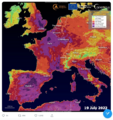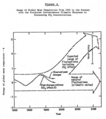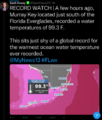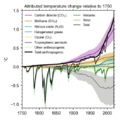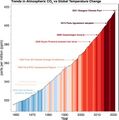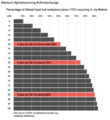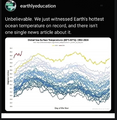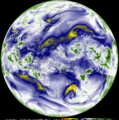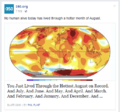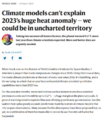Category:Ocean Science: Difference between revisions
Siterunner (talk | contribs) No edit summary |
Siterunner (talk | contribs) No edit summary |
||
| Line 27: | Line 27: | ||
<font color=blue>○ ○ ○ ○ ○ ○ ○ ○ ○</font> <font color=green>○ ○ ○ ○ ○ ○ ○ ○ ○</font> | <font color=blue>○ ○ ○ ○ ○ ○ ○ ○ ○ ○ ○ ○</font> <font color=green>○ ○ ○ ○ ○ ○ ○ ○ ○ ○ ○ ○</font> | ||
| Line 361: | Line 361: | ||
[[Category:Climate Change]] | |||
[[Category:Climate Policy]] | |||
[[Category:Ocean Ecosystem]] | [[Category:Ocean Ecosystem]] | ||
[[Category:Oceans'' | |||
Revision as of 01:33, 14 July 2022
<addthis />
Improved Quantification of the Rate of Ocean Warming
July 15, 2022
Read full article at Journal of Climate, Published Online
Abstract
The increased concentrations of greenhouse gases in the atmosphere create an increase in Earth’s thermal energy, which is mainly stored in the ocean. Quantification of the rate of increase in ocean heat content (OHC) is vital for understanding the current and future climate of Earth. Linear trend lines have been frequently used to quantify long-term rates of change, but are inappropriate because they cannot capture nonlinearity in trends, have large start- and end-point sensitivity, and the assumption of linearity is nonphysical. Here observed and model-based linear regressions with higher-order polynomial (quadratic), piecewise linear, and locally weighted scatterplot smoothing (LOWESS) are compared. Piecewise linear and LOWESS perform best in depicting multidecadal trends. It is shown that linear rates are valid for up to about 15-yr segments (i.e., it is valid to compute linear rates within a 15-yr time window). Using the recommended methods, ocean warming for the upper 2000 m increases from about 0 to 0.06 ± 0.08 W m−2 for 1958–73 to 0.58 ± 0.08 W m−2 for 2003–18, indicating an acceleration of ocean warming that happens in all four ocean basins and from near the sea surface to 2000 m. There is consistency between multimodel-mean historically forced climate models and observations, which implies that the contribution of internal variability is small for global 0–2000 m OHC. Notable increases of OHC in the upper ocean (i.e., 0–300 m) after about 1980 and the deeper ocean (300–2000 m) after the late 1980s are also evident. This study suggests alternative methods to those currently used to estimate ocean warming rates to provide a more accurate quantification of long-term Earth’s energy changes.
Significance Statement
Quantifying long-term rates of change is needed to understand the time evolution of ocean warming and to assess the changing ocean and Earth’s energy budgets. Linear trend lines have been frequently used but cannot capture nonlinearity in trends, and have large start- and end-point sensitivity. Based on an analysis of the statistical features of ocean heat content time series, this study proposes two alternative methods to quantify the rates of change, including piecewise linear fit and LOWESS. Robust increases in warming for the upper 2000 m detected through observational records and climate models from 1958 to 2020, indicate a robust acceleration of ocean warming. Slow penetration of heat from the upper ocean into the deeper ocean is also evident.
Abstract-Significance Statement made available via Fair Use
Full article © 2022 American Meteorological Society
○ ○ ○ ○ ○ ○ ○ ○ ○ ○ ○ ○ ○ ○ ○ ○ ○ ○ ○ ○ ○ ○ ○ ○
Report for a Sustainable Ocean Economy
Ocean Solutions that Benefit People, Nature and the Economy
The raw numbers are sobering: ocean waters have absorbed 93 percent of the excess heat caused by greenhouse gas [GHG] emissions and sea surface temperatures have increased by 0.7°C since 1900. New analysis confirms that 2019 was the warmest year on record for ocean temperature, and saw the largest single-year increase of the decade. The 12 years with lowest Arctic sea ice extent all happened in the past dozen years140, and 2017 marked the lowest Antarctic sea ice extent on record.
○ ○ ○ ○ ○ ○ ○ ○ ○ ○ ○ ○ ○ ○ ○ ○ ○ ○
Science on the Seas (SOS)
The 'Tiny Little Ones'
○ ○ ○ ○ ○ ○ ○ ○ ○ ○ ○ ○ ○ ○ ○ ○ ○ ○ ○ ○
Microplastic Pollution Across World Oceans
'Ginormous' Disaster in the Making
"Plastic Particles may outnumber zooplankton, which underpin marine life and regulate climate"
Microplastics have entered the food chain in rivers, with birds found to be consuming hundreds of particles a day via the aquatic insects on which they feed.
Microplastic pollution has contaminated the whole planet, from Arctic snow and mountain soils to many rivers and the deepest oceans. It is also being consumed and inhaled by people, and the health impacts are as yet unknown.
Research published in the last month in the Journal of 'Environmental Pollution' has found microplastics in greater quantities than ever before on the seabed and suggested that hundreds of thousands of tonnes of microplastics could be blowing ashore on the ocean breeze every year...
The Rise of the Jellyfish
Invasion across the oceans of the world
After roaming the oceans for more than a half billion years, jellyfish may finally be poised to overtake Earth's largest bodies of water. A combination of pollution and warming is fostering a perfect environment for the alien-looking creatures to rule the seas.
Thousands of species fall under the jellyfish umbrella, similar only in their basic body composition and tendency in undergoing sudden population booms. Some scientists use the term “gelatinous zooplankton”... Jellyfish may finally be poised to overtake Earth's largest bodies of water.
'Jellymageddon': Can we stop the rise of the jellyfish?
○ ○ ○ ○ ○ ○ ○ ○ ○ ○ ○ ○ ○ ○
Seagrass: A 'Secret Weapon' Against Global Heating
○ ○ ○ ○ ○ ○ ○ ○ ○ ○ ○ ○ ○ ○
Molecular Understanding of Ocean Warming
Peter G. Brewer
July 2019
A grand challenge for ocean chemists in the years ahead lies in the need to tackle the chemical consequences of ocean warming with the same rigor and intensity that has been brought to bear on the physical chemistry of ocean acidification...
The ocean absorbs some 93% of all greenhouse gas‐generated heat, and ocean warming is already creating observable impacts on marine life. To make reliable projections for the future, we cannot rely on Ptolemy‐like rules, built as something to match field observations, to apply in the years to come. Instead, we will need to apply the laws of chemical physics to calculate and predict the changes that ocean warming will have on the physical properties of sea water and the associated impacts on marine life. This includes treating water as a fluid with defined temperature‐and pressure‐dependent chemical structures.
Sea water is 96.5% water, and some 78–85% of water in the oceans has a form with a much higher molecular weight than the water molecule that typically comes to mind, with a single oxygen and two hydrogens. These varied structures are now directly relatable to the high heat capacity of water, why the speed of sound is faster in warmer water, and the viscosity of sea water that provides constraints on microbial motion. Microbial activity is a key driver to the amount of oxygen in different parts of the ocean, and if their activity is affected by increased warmth, it seems quite possible that large regions may exist with no oxygen at all. Marine life responds strongly to changing oxygen status. This is because both warmer waters can hold less oxygen, and because warming drives higher rates of microbial growth.
Marine fisheries, and the great majority of all marine species, are already responding to these forces and are migrating toward cooler waters near the poles. Using known laws of science to connect chemistry, physics, and ocean warming would allow the ocean sciences to proceed on firmer footing and to improve future projections of the impact of ocean warming. The ocean is now experiencing the twinned invasions of heat and fossil fuel carbon dioxide that drive up its acid level. It is the combined impact of these two great waves, both resulting from our use of fossil fuels, that will be critical...
○ ○ ○ ○ ○ ○ ○ ○
Seaweed, not just seaweed but a 'Sea of Seaweed'
Warming oceans produce abundant 'weed'
Satellites tracking 'the weed'
- Satellites in Space Spot Largest Seaweed Bloom on Earth
The great Atlantic Sargassum belt
Floating mats of Sargassum seaweed in the center of the North Atlantic were first reported by Christopher Columbus in the 15th century. These mats, although abundant, have until recently been limited and discontinuous. However, Wang et al. report that, since 2011, the mats have increased in density and aerial extent to generate a 8850-kilometer-long belt that extends from West Africa to the Caribbean Sea and Gulf of Mexico. This represents the world's largest macroalgal bloom. Such recurrent blooms may become the new normal.
Seaweed, seaweed everywhere
Millions of tonnes of floating Sargassum seaweed in coastal waters smother fragile seagrass habitats, suffocate coral reefs and harm fisheries. And once washed ashore on Mexican and Caribbean beaches, this foul-smelling, rotting seaweed goes on to devastate the tourist industry, prevent turtles from nesting and damage coastal ecosystems, while releasing hydrogen sulphide and other toxic gases as it decomposes.
Seaweed blooms are exacerbated by fertilisers washing into the ocean, as well as by warming sea temperatures. “Sargassum blooms on the Atlantic gyre [tidal current] have got much worse in recent years partly due to increasing intensive agriculture discharging fertiliser into the sea via rivers such as the Mississippi and Amazon,” says Prof Mike Allen, of the University of Exeter and Plymouth Marine Laboratory. “Fertiliser makes the seaweed grow faster and this influx of biomass just shouldn’t be there in that abundance – it’s out of control.”
Sargassum: The biggest seaweed bloom in the world
Sargasso Sea (video) from the Smithsonian Channel
○ ○ ○ ○ ○ ○ ○ ○
Monitoring Earth's Oceans from Space
- Will the new availability of sophisticated, satellite-based technologies, coupled with the democratization of online data about the health of our environment, help ensure that these positive advancements live up to their potential to protect the oceans?
○ ○ ○ ○ ○ ○ ○ ○
"What percentage of the Earth is covered by oceans?"'
71% -- Via http://www.noaa.gov/oceans-coasts
·······························
Phytoplankton & Photosynthesis
Plankton: The Ocean Food Chain & Atmospheric Oxygen
"Tiny Blue Green"
- More than Meets the Eye
"A single kind of blue-green algae in the ocean produces the oxygen in one of every five breaths we take"
- ~ from "The World Is Blue: How Our Fate and the Ocean’s Are One" by Sylvia Earle
○ ○ ○ ○ ○ ○ ○ ○ ○ ○ ○ ○ ○ ○
Impacts of Ocean Warming /AGU Science - Geophysics
○ ○ ○ ○ ○ ○ ○ ○ ○ ○ ○ ○ ○ ○
Visit:
www.tinybluegreen.com @GreenPolicy360
Seventy percent of the Earth's surface is ocean and here, in myriad life forms, "tiny blue-green" organisms are essential to preserving life on the planet.
○ ○ ○ ○ ○ ○ ○ ○
Join in Planet Scientists, do some difference-making Citizen Science
○ ○ ○ ○ ○ ○ ○ ○
Sea-Level Rise
○ ○ ○ ○ ○ ○ ○ ○
Mapping & Tracking
○ ○ ○ ○ ○ ○ ○ ○
Open Science Access to Ocean Research
○ ○ ○ ○ ○ ○ ○ ○
Global Impacts of Ocean Acidification and Warming
- To gather a more comprehensive understanding of the condition of global reef ecosystems, we need a way to assess and monitor them on a large geographic scale.
- The Reefscape project aims to improve our understanding of the condition of coral reefs worldwide, while simultaneously developing spectral libraries needed to advance the development of a new satellite mission.
- New satellites, such as those from Planet (formerly Planet Labs), are, as of 2017, able to capture near-daily imagery of coral reefs worldwide. Planet’s high-resolution imagery of reef locations provides new imaging, science and understanding of the composition and extent of shallow, horizontally oriented reefs.
Reefs and Coral, sentinel species
Coral reefs in peril as ocean environment is transformed
○
Ocean Research Missions - http://schmidtocean.org/
○
○
[[Category:Oceans
Subcategories
This category has the following 21 subcategories, out of 21 total.
A
B
C
E
F
G
N
O
P
S
T
W
Pages in category "Ocean Science"
The following 99 pages are in this category, out of 99 total.
A
C
- Carbon Brief
- Citizen Science
- Climate Change - Global Warming Keyword-Terms
- Climate Change Denier Talking Points -- and Rebuttals
- Climate Change Summit Paris
- Climate Desk
- Climate Law Blog @Columbia Law School
- Climate migration
- Climate News
- Climate News Events Archive ... 1970 to Today
- Climate Plans Enforcement - Resources
- Copernicus EU
E
- Earth and Space, Politics
- Earth at Night
- Earth from NASA
- Earth Imaging-New Space
- Earth Right Now
- Earth Science
- Earth Science Eco-Fields
- Earth Science Research from Space
- Earth Science Vital Signs
- EarthTime
- Ecolivia
- Environmental agreements
- Environmental movement
- Environmental protection
- Environmental Rules Rolled Back
- ESA Living Planet Announcement - May 2022
- Ethics and Climate Change
- European Union Green Deal - Fit for 55
- Extinction
- ExxonMobil and US House Science Committee v US Attorneys General and Environmental Groups
G
- Glasgow Climate Summit - Pledges, Promises, Declarations - What's Next Up
- Global Climate Action Summit
- Global Fishing Watch
- Global warming
- Google Earth
- GP360 NewPages
- Green Marketing
- Green Stories of the Day
- Green Stories of the Day - GreenPolicy360 Archive
- GreenPolicy360 Archive Highlights 2013
- GreenPolicy360 Archive Highlights 2014
- GreenPolicy360 Archive Highlights 2015
- GreenPolicy360 Archive Highlights 2016
- GreenPolicy360 Archive Highlights 2017
- GreenPolicy360 Archive Highlights 2018
- GreenPolicy360 Archive Highlights 2019
- GreenPolicy360 Archive Highlights 2020
- GreenPolicy360 Archive Highlights 2023
- GreenPolicy360 Highlights
P
S
U
Media in category "Ocean Science"
The following 200 files are in this category, out of 835 total.
(previous page) (next page)- Doves launched from ISS float against Earth horizon.jpg 4,256 × 2,832; 564 KB
- Drawdown Solution Chart.png 800 × 450; 186 KB
- Drawdown top ten solutions - 2017.png 498 × 654; 179 KB
- Drawdown.jpg 352 × 450; 53 KB
- DSCOVR EPIC - July 20 2022.png 532 × 612; 315 KB
- DSCOVR w EPICcam, PlasMag & NISTAR.png 1,219 × 785; 1.49 MB
- DSCOVR w EPICcam.png 800 × 515; 968 KB
- E&E.png 800 × 510; 474 KB
- Eaarth.gif 150 × 224; 7 KB
- Earth - Pacific Ocean.png 504 × 602; 233 KB
- Earth 3D Overview.jpg 1,024 × 768; 190 KB
- Earth AI - Feb 2022.png 482 × 480; 192 KB
- Earth and atmosphere from Suomi.jpg 1,484 × 1,113; 349 KB
- Earth and Space, Politics.png 796 × 765; 349 KB
- Earth atmosphere and night 1024x551.jpg 1,024 × 551; 138 KB
- Earth atmosphere and night-1920x1080.jpg 1,920 × 1,080; 390 KB
- Earth atmosphere ISS October30,2014.jpg 590 × 392; 12 KB
- Earth atmosphere.jpg 1,440 × 1,080; 153 KB
- Earth Breathing.jpg 800 × 450; 117 KB
- Earth conditions dynamic map.png 673 × 673; 770 KB
- Earth Day 2021 - Climate Summit News-1.jpg 491 × 270; 127 KB
- Earth Day 50 years on.jpg 480 × 548; 107 KB
- Earth gets hotter May2016.jpg 500 × 322; 28 KB
- Earth in Human Hands.jpg 325 × 385; 34 KB
- Earth Information Center - 2022 Graphic NASA.png 800 × 981; 868 KB
- Earth Information Center - NASA 336.png 336 × 336; 279 KB
- Earth Information Center - NASA.png 768 × 769; 1.21 MB
- Earth Information Center from NASA.jpg 800 × 577; 94 KB
- Earth mapped.png 800 × 783; 254 KB
- Earth Observing System - fleet of satellites.png 740 × 576; 557 KB
- Earth POV from the ISS Cupola-m.jpg 800 × 480; 71 KB
- Earth Research Findings 2015 1.png 1,088 × 686; 1.49 MB
- Earth Research Findings 2015 2.png 1,088 × 241; 512 KB
- Earth Right Now science.jpg 197 × 49; 3 KB
- Earth satellites in 3D.jpg 640 × 350; 213 KB
- Earth Science Research from Space.png 800 × 256; 208 KB
- Earth Science Vital Signs, Pulse of the Planet Climate Essentials.png 692 × 441; 207 KB
- Earth Science Vital Signs, Pulse of the Planet EOS NASA 2014.png 758 × 776; 366 KB
- Earth Summit 1992-s.png 336 × 418; 283 KB
- Earth Summit 1992.jpg 600 × 746; 171 KB
- Earth System Observatory-1.jpg 580 × 833; 129 KB
- Earth System Observatory-2.jpg 580 × 831; 69 KB
- Earth trapping unprecedented amount of heat - NASA.jpg 468 × 373; 56 KB
- Earth Viewing from the International Space Station.jpg 496 × 307; 45 KB
- Earth's atmosphere 1536x864.jpg 1,536 × 864; 48 KB
- Earth's atmosphere 3840x2160.jpg 3,840 × 2,160; 204 KB
- Earth's atmosphere 814x458.jpg 814 × 458; 23 KB
- Earth-Moon 768x432.jpg 768 × 432; 20 KB
- Earth-upper-atmosphere-NASA.jpg 800 × 781; 327 KB
- EarthDecadel Priorities-2018.jpg 779 × 529; 85 KB
- EarthPOV 1920x1080.jpg 1,920 × 1,080; 270 KB
- EarthRightNow Earth Science satellite fleet circa 2015.jpg 1,500 × 1,125; 0 bytes
- Earths Atmospheric Layers.JPG 800 × 532; 34 KB
- Earths-atmosphere-from-ISS.jpg 1,536 × 864; 114 KB
- EarthsAtmosphere 4628x1500.jpg 4,628 × 1,500; 1.45 MB
- EarthScience Missions via the EOS - 2022.png 800 × 219; 139 KB
- Earthview ISS Shuttle.jpg 1,152 × 648; 0 bytes
- Earthview nasa date-unknown search1.jpg 768 × 432; 79 KB
- Economist.com global capital snapshot as of July 2020.jpg 800 × 477; 119 KB
- Eiffel tower green.jpg 759 × 422; 28 KB
- Elon Musk quote - gas externality price.png 680 × 320; 199 KB
- Emissions graph - gleick tw 2018.jpg 640 × 364; 37 KB
- Energy Charter Treaty.jpg 512 × 480; 74 KB
- Energy Imbalance, Climate Change - Aug 1 2021.png 640 × 672; 394 KB
- Env policy laws US 'the beginning' of env era.jpg 370 × 345; 65 KB
- Environmental laws in US - Supreme Court votes soon.png 800 × 414; 334 KB
- Environmental Security ThinBlueLayer.png 814 × 677; 469 KB
- EnvirSecurity.png 558 × 166; 155 KB
- EO and Fire Ants in the US - on World Wildlife Day.png 768 × 811; 663 KB
- EPA History Xin Liu-2010.pdf ; 2.88 MB
- EPA website a 'ghost page' now.png 667 × 233; 45 KB
- ESA ers2-envisats-tandem s.jpg 451 × 298; 34 KB
- ESA Living Planet Symposium - Announcement.png 637 × 600; 508 KB
- ESA Living Planet Symposium - May 2022.png 700 × 600; 258 KB
- ESG Fight - Feb 2023.png 396 × 194; 88 KB
- Estates at Acqualina - Sunny Isles Miami.jpg 746 × 600; 117 KB
- Estuary in Clearwater on Tampa Bay.jpg 3,584 × 2,016; 1.5 MB
- EU agrees to cut emissions 55 percent by 2030.jpg 800 × 558; 96 KB
- EU unveils new climate change policy - July 14 2021 - 1.jpg 800 × 234; 33 KB
- EU unveils new climate change policy - July 14 2021 - 2.jpg 800 × 552; 86 KB
- EU unveils new climate change policy - July 14 2021 - 3.jpg 800 × 549; 89 KB
- EU unveils new climate change policy - July 14 2021 - 4.jpg 800 × 550; 92 KB
- EU unveils new climate change policy - July 14 2021 - 5.jpg 800 × 548; 88 KB
- EU unveils new climate change policy - July 14 2021 - 6.jpg 800 × 557; 89 KB
- EU unveils new climate change policy - July 14 2021 - 7.jpg 800 × 553; 92 KB
- EU unveils new climate change policy - July 14 2021 - 8.jpg 800 × 589; 91 KB
- Eukaryotic Cell SCU.jpg 716 × 1,024; 799 KB
- Eunice Foote Illustration climate.gov.jpg 620 × 296; 55 KB
- Europe heat wave - July 19 2022 - via Copernicus satellite.png 600 × 639; 704 KB
- Extreme temperature-world-May 2024.jpg 640 × 427; 105 KB
- ExxonMobil CO2 climatic response study - Graphic 1 - 1982.png 537 × 680; 150 KB
- ExxonMobil CO2 climatic response study - Graphic 2 - 1982.png 537 × 605; 112 KB
- FaceApp Florida.jpg 640 × 428; 40 KB
- Fact Checking organizations at work.jpg 800 × 390; 44 KB
- Facts about US Energy Use.jpg 697 × 600; 101 KB
- Facts Count-WaPo Reports-19127 false-misleading claims in 1226 days.jpg 601 × 489; 100 KB
- Feeling the Heat 1989.png 800 × 1,095; 400 KB
- Fire Ants.png 601 × 600; 603 KB
- Floating adaptations - GCA - for sea-level rise - circa 2023.png 600 × 732; 273 KB
- Floating Forest Project .png 773 × 461; 932 KB
- Floating Forest Project.png 1,106 × 604; 1,020 KB
- Floating Forests-Kelp -- Oceanlight.jpg 720 × 480; 137 KB
- Flooding in South Florida.png 640 × 742; 293 KB
- Floodwaters from Hurricane Helene in Feather Sound, Florida.jpeg 469 × 640; 163 KB
- Florida 2024 Heating up and upset.jpg 460 × 581; 89 KB
- Florida and climate change denial.png 640 × 192; 46 KB
- Florida governor and legislature strike climate science - 2024.png 640 × 105; 42 KB
- Florida Keys sea surface temps for 2023 (as of July).png 480 × 585; 287 KB
- Florida ocean water temp south of Everglades tops 99 F. degrees.png 480 × 564; 128 KB
- Florida sea rise ab.jpg 256 × 197; 12 KB
- Florida sea surface water in the Keys area tops 100 degree F.jpg 640 × 257; 58 KB
- Florida-sea-level-rise.jpg 400 × 400; 125 KB
- Foley on March29,2017.png 487 × 135; 0 bytes
- FOOD.jpg 983 × 311; 117 KB
- Fox on Earth Day 2023.jpg 640 × 275; 58 KB
- From 1968 to 1992 -- and the Journey continues....png 572 × 851; 320 KB
- From Reid Wiseman Earth Ocean Patterns.png 941 × 578; 715 KB
- G Earth Outreach.jpg 800 × 412; 44 KB
- Gavin in Glasgow - Nov 10 2021.png 728 × 600; 378 KB
- GCAS original.png 800 × 504; 94 KB
- GCAS-2.jpg 800 × 450; 136 KB
- GHG emissions 1970-2010.jpg 800 × 438; 50 KB
- GHG forcings 1750-2020.png 531 × 531; 94 KB
- GHG ppt concentrations 1975-2020.jpg 640 × 361; 69 KB
- Gistemp 1979-2019.png 750 × 491; 335 KB
- Glasgow-Climate Conference News-Nov 6, 2021.png 600 × 800; 290 KB
- Global Biodiversity Information-Data.png 501 × 266; 124 KB
- Global Changes in temperature 1850-2020.jpg 480 × 480; 152 KB
- Global Climate Change textbook-Edition2.jpg 604 × 680; 96 KB
- Global climate conferences and GHG increases.jpg 793 × 801; 56 KB
- Global Climate Dashboard - NOAA - Climate.gov.png 630 × 480; 165 KB
- Global climate dashboard-NOAA climate.gov.jpg 521 × 221; 45 KB
- Global climate dashboard-www.climate.gov.jpg 800 × 489; 100 KB
- Global Climate Dashboard.jpg 800 × 529; 101 KB
- Global Climate Strike - RU.jpg 450 × 804; 116 KB
- Global Fishing Watch 2.jpg 266 × 247; 26 KB
- Global fossil fuel emissions - in a lifetime graphic.png 600 × 657; 233 KB
- Global greenhouse gas emissions - 1980 - 2020.png 640 × 480; 158 KB
- Global Primary Energy Consumption - 1800-2017.jpg 800 × 583; 65 KB
- Global sea surface temperature 1982-2024.png 800 × 823; 566 KB
- Global sea surface temperature graph as of 2024.png 800 × 455; 654 KB
- Global Stocktake, the first GST.jpg 800 × 905; 513 KB
- Global temperature change 1850-2016.gif 512 × 288; 1.38 MB
- Global temperature change 1901-2000.jpg 640 × 508; 47 KB
- Global temperature variations over past 200 years.jpg 640 × 360; 29 KB
- Global warming June 2024.jpg 640 × 174; 46 KB
- GlobalClimateStrike-March15,2019.jpg 600 × 613; 30 KB
- Globally-averaged temps thru 2015 via NASA Goddard.gif 480 × 270; 1.76 MB
- GND next steps.png 567 × 660; 304 KB
- Good science needs good data .png 579 × 420; 223 KB
- Google Earth Hello2.png 800 × 375; 863 KB
- GP360 tagcloud2 m.png 531 × 324; 132 KB
- Great Barrier Reef dying.jpg 1,920 × 1,280; 706 KB
- Great Barrier Reef May 2016 m.png 700 × 196; 170 KB
- Great Barrier Reef May 2016.png 771 × 213; 182 KB
- Great Barrier Reef severe bleaching die-off.png 704 × 388; 630 KB
- Great-barrier-reef-2011 image credit, mike mccoy.jpg 2,560 × 1,600; 3.91 MB
- Green dragon over Iceland 2015 Belegurshi.jpg 960 × 960; 57 KB
- Green New Deal, work in progress.jpg 800 × 450; 62 KB
- Greenhouse gas levels hit record - Reuters.jpg 600 × 696; 104 KB
- Greenland ice sheet set to raise sea level significantly.png 640 × 340; 223 KB
- GreenLinks logo - 2.png 451 × 84; 13 KB
- GreenLinks logo.png 644 × 120; 10 KB
- GreenPolicy360 - May- 9-2024.png 800 × 406; 119 KB
- GreenPolicy360 - May-10-2024.png 790 × 694; 320 KB
- Greta - the politics thats needed.jpg 639 × 203; 38 KB
- Greta anger into action.png 800 × 419; 528 KB
- Greta Looks Back.PNG 504 × 437; 368 KB
- Greta Thunberg - Week 203 Climate Strike Banner.png 209 × 127; 51 KB
- Greta Thunberg - Week 203 Climate Strike.png 554 × 601; 488 KB
- Group on Earth Observations.JPG 546 × 418; 33 KB
- Guarding Earths Water - from Space.jpg 578 × 496; 102 KB
- Gulf Stream in Critical Danger.pdf ; 181 KB
- Haiku poems - Owl against a dusk sky - via Haiku Foundation.png 514 × 413; 144 KB
- Haikubox via RM citizen science.png 600 × 640; 466 KB
- Harvey-NOAA.jpg 960 × 643; 173 KB
- Heat hitting billions.png 614 × 690; 509 KB
- Heat stress in US may double by end of century.jpg 640 × 503; 107 KB
- High Seas Treaty agreement - March 4 2023.png 617 × 498; 53 KB
- Himawari Earth water vapor dynamics.png 768 × 774; 917 KB
- Historic climate-clean energy vote in US Congress August 12 2022.jpeg 800 × 775; 384 KB
- Historic gulf of mexico warm water.png 800 × 306; 148 KB
- Historic heat in gulf of mexico.png 800 × 810; 590 KB
- Historic photographs - Humble Oil TX - Exxon.png 591 × 596; 548 KB
- Hotimes.png 514 × 481; 201 KB
- Hourglass-sand-2.jpg 450 × 342; 12 KB
- House passes biggest climate investment in U.S. history.png 625 × 480; 114 KB
- How satellites monitor climate change circa 2016.png 599 × 327; 0 bytes
- How thin is earth's atmosphere.jpg 605 × 292; 61 KB
- Huge heat anomaly in 2023 - by Gavin Schmidt.png 735 × 857; 172 KB
- Hurricane-Proofing-Home-2024-Miami-Florida.png 658 × 600; 652 KB
- Hurricanes - Typhoons via NASA data.png 764 × 924; 1,022 KB
- I Am Greta - the Documentary.jpg 387 × 485; 30 KB

